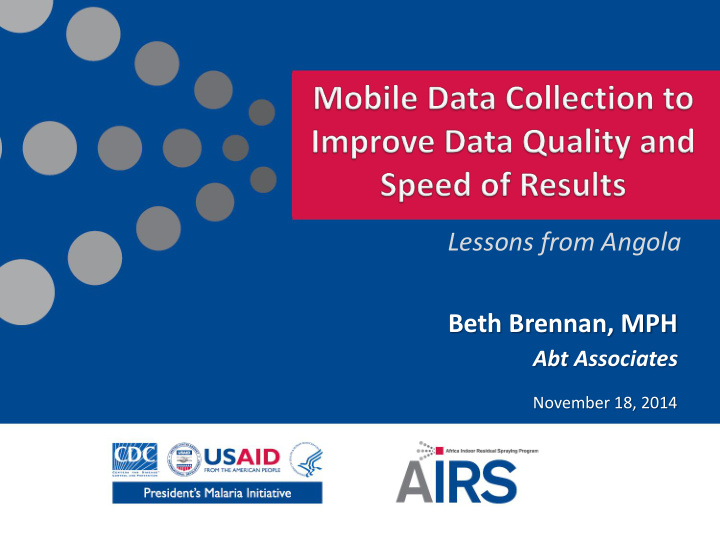



Lessons from Angola Beth Brennan, MPH Abt Associates November 18, 2014
Background Pilot Design Results Recommendations 2
Africa Indoor Residual Spraying - President’s Malaria Initiative Large volume of manual data collection Multiple remote sites Quality control difficulty Data transport and entry time 3
• Spray data collection with smartphones What? • “Real - time” quality control with tablets Who? 48 SOPs, 8 TLs Where? Huambo, Angola (~12,000 houses) When? October 2013 IRS Campaign • Quick data and reporting • Data accuracy Why? • GIS mapping/geo-coding • Establish mobile system for HH-level surveys • Potential cost savings 4
5
6
TL verifies SOP collects data Submits to cloud data and flags Submits to by spray form cloud errors M&E Mgr reconciles data, and generates Contacts TL reports Sr Mgmt has Mgmt makes operational adjustments current data 7
‣ Record GIS coordinate
Team Leader Data Quality Check
Team Leader Data Quality Check SOP #22 returned 3 sachets full, 2 empty
12
48 SOPs trained 36 proved capable 9 switched to paper by day #3 27 used phones (56%) 13
Quick data for operational feedback Established mobile M&E system Robust QC system Capacity built in seasonal staff Successful inventory system 14
Low literacy population Piloted villages new to IRS An alphabetical vs. QWERTY keyboard Initial tech failures in QC system Data cleaning laborious 15
Pilot in higher literacy areas Task team leaders to collect data for 2-3 SOPs Increase length of training Enhance view of QC system Analyze spray coverage (i.e. GIS) with epi/ento trends Compliment paper-based data with mobile platforms 16
Mobile phones for: ◦ supervisory purposes ◦ operational and spray campaign decision-making ◦ epi data collection in select health facilities ◦ mass-messaging for IEC/BCC 17
Beth_ th_Br Bren ennan an@a @abtassoc.com btassoc.com
Recommend
More recommend